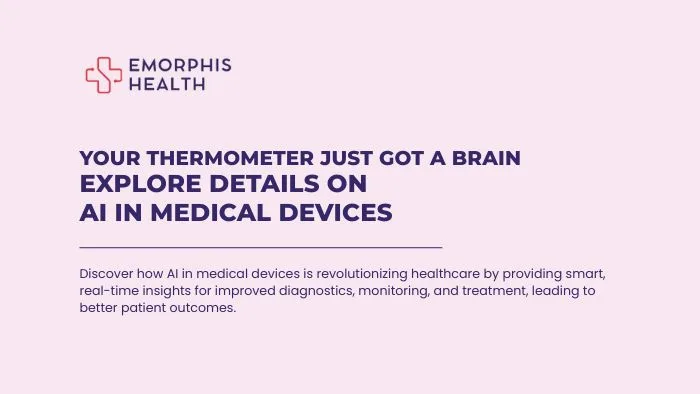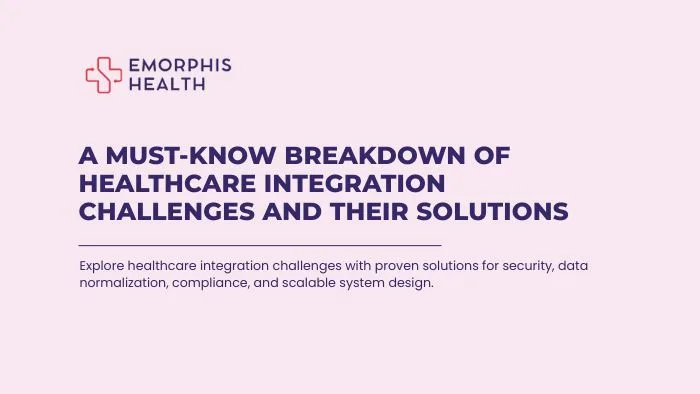Here, “Your Thermometer Just Got a Brain” signifies the integration of AI into medical devices, making them smarter and more accurate. AI in medical devices empowers tools like thermometers to analyze data, predict outcomes, and enhance patient care.
So, let us check in detail now,
AI Enters the World of Medical Devices
See Contents
- 1 AI Enters the World of Medical Devices
- 2 What Is AI in Medical Devices?
- 3 Inside the Device: How AI Works
- 4 Real-World Applications of AI in Medical Devices
- 5 Benefits of AI-Powered Medical Devices
- 6 Compliance and Regulatory Landscape
- 7 The Future of AI in Medical Devices
- 8 Conclusion: The Rise of Intelligent Devices in Healthcare
No longer confined to research labs or futuristic fiction, artificial intelligence is now embedded in the very tools that doctors and patients use every day. Whether it’s a smart thermometer that adapts to patient history or a wearable that predicts heart irregularities, AI in medical devices is transforming clinical workflows, diagnostics, and patient care.
With the growing demand for intelligent healthcare solutions and the ongoing digital transformation in hospitals, integrating AI is no longer just an innovation, it’s a necessity. The global market for AI in medical devices is to grow at an impressive 44.6% annual rate. This rapid growth highlights the increasing reliance on AI-driven healthcare technologies that provide better patient outcomes, smarter diagnostics, and enhanced operational efficiencies (GlobeNewswire, 2024).
Manufacturers, healthcare providers, and startups are competing to develop and acquire AI-powered medical equipment that addresses the evolving needs of modern healthcare. The broader medical device market, including AI integration, is projected to grow from $810.4 billion in 2024 to $1.3 trillion by 2029, representing a 9.8% compound annual growth rate (CAGR). This rise underscores the critical importance of AI in shaping the future of healthcare, enabling innovations across diagnostics, monitoring, and treatment (GlobeNewswire, 2024).
What Is AI in Medical Devices?
AI in medical devices refers to the incorporation of artificial intelligence technologies, such as machine learning, computer vision, and natural language processing, into hardware used for medical diagnostics, treatment, or monitoring. These devices can analyze data, learn from patient patterns, and make real-time decisions to improve care delivery.
From automated image interpretation to adaptive prosthetics, these devices are evolving from passive instruments to active participants in the care journey. Unlike traditional medical tools that rely on manual inputs and static programming, AI-powered healthcare tools continuously improve their performance based on new data inputs, leading to faster and more accurate results.
Inside the Device: How AI Works
Understanding how AI in medical devices functions reveals why it is so effective. These smart devices typically consist of three core components:
- Sensors: Collect physiological or environmental data, such as heart rate, glucose levels, or motion.
- Embedded Processors: Use AI algorithms to analyze sensor data and detect patterns or anomalies.
- Communication Interfaces: Relay insights to healthcare providers or patients in real time.
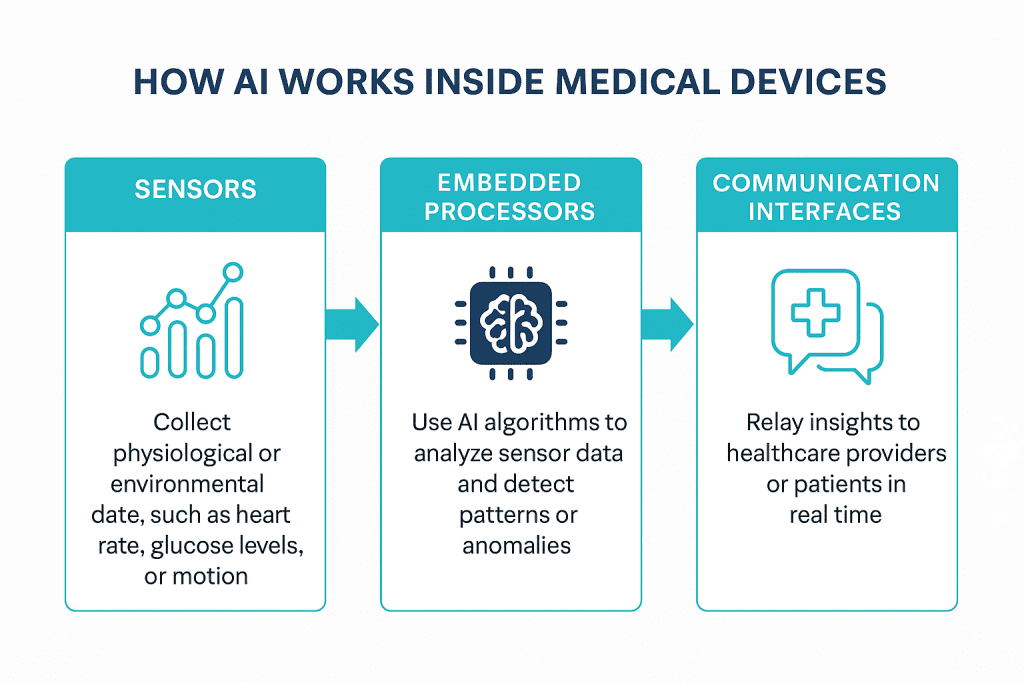

For instance, a smart cardiac monitor can detect abnormal rhythms by continuously learning from a patient’s unique heart pattern. Devices may use edge AI, where processing happens on the device itself, or cloud-based systems that offer more powerful computational resources. Either way, AI in medical devices enables rapid, autonomous decision-making, crucial in time-sensitive healthcare settings.
Real-World Applications of AI in Medical Devices
AI is revolutionizing the medical device industry by enabling smarter, more responsive tools that support diagnosis, treatment, and patient management. These AI-powered devices are no longer experimental—they’re in hospitals, clinics, and even homes.
Below is an in-depth look at how AI is practically embedded in different types of medical devices:
1. AI-Enabled Diagnostic Devices
1.1. Smart ECG Machines
AI algorithms embedded in ECG devices can detect irregular heart rhythms such as atrial fibrillation, bradycardia, and tachycardia in seconds. These devices often flag high-risk readings before symptoms even appear, enabling early intervention and reducing the risk of cardiac events.
1.2. Digital Stethoscopes
Traditional stethoscopes rely on a physician’s trained ear. AI-enhanced stethoscopes analyze auscultated sounds in real-time, identifying subtle heart murmurs, abnormal lung sounds, or wheezing. These tools assist in faster, more accurate detection of cardiovascular and respiratory diseases, even for less experienced practitioners.
1.3. AI-Enhanced Spirometers
Used in pulmonary diagnostics, these devices employ machine learning models to evaluate lung function. They can predict the likelihood of asthma attacks, chronic obstructive pulmonary disease (COPD) progression, or post-operative complications, helping clinicians tailor interventions.
2. AI in Wearable Medical Devices
2.1. Continuous Glucose Monitors (CGMs)
Modern CGMs use AI to learn a patient’s glucose trends. These devices provide predictive alerts about potential hyperglycemia or hypoglycemia events, offering a safety net for diabetics and reducing the risk of diabetic shock or coma.
2.2. Cardiac Wearables
Smartwatches with medical-grade ECG sensors detect irregular heartbeats and can even differentiate between types of arrhythmias. AI monitors heart rate variability (HRV) to predict stress, fatigue, or underlying cardiovascular conditions.
2.3. Fall Detection Devices
These wearables use motion sensors and AI to distinguish between normal movements and dangerous falls. Some can predict high fall risk based on gait analysis, prompting early interventions like physiotherapy or environment adjustments.
2.4. Sleep Apnea Monitors
Wearables and headbands equipped with AI track oxygen saturation, breathing patterns, and sleep cycles. The AI identifies signs of sleep apnea, such as prolonged pauses in breathing or excessive snoring, offering a non-invasive alternative to traditional sleep studies.
3. AI-Driven Imaging Devices
3.1. AI-Assisted Ultrasound Machines
These devices help less experienced users capture clinically relevant images by guiding probe placement and automatically identifying anatomical structures. AI also interprets results, assisting in early detection of issues like ectopic pregnancies or internal bleeding.
3.2. MRI and CT Scanners with AI
Advanced imaging devices use deep learning to enhance image quality, reconstruct high-resolution images faster, and flag abnormalities like tumors, blood clots, or infections. AI reduces human error and accelerates reporting time.
3.3. Portable Imaging Devices
Handheld AI-powered ultrasound or X-ray devices are especially valuable in rural or emergency settings. They allow frontline health workers to perform on-the-spot imaging and receive instant AI analysis, enabling quick triage and referral decisions.
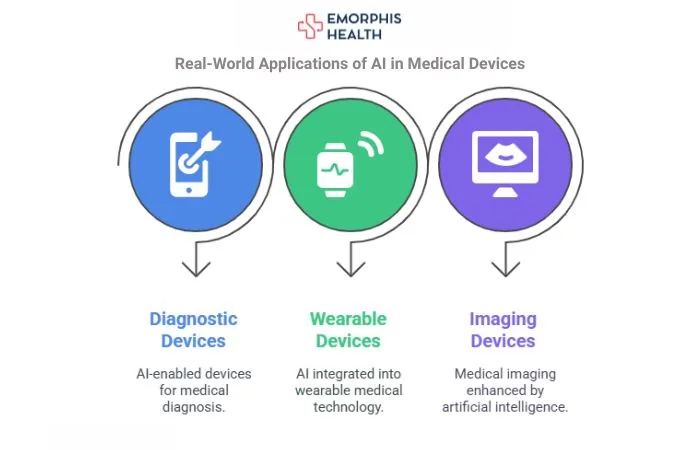

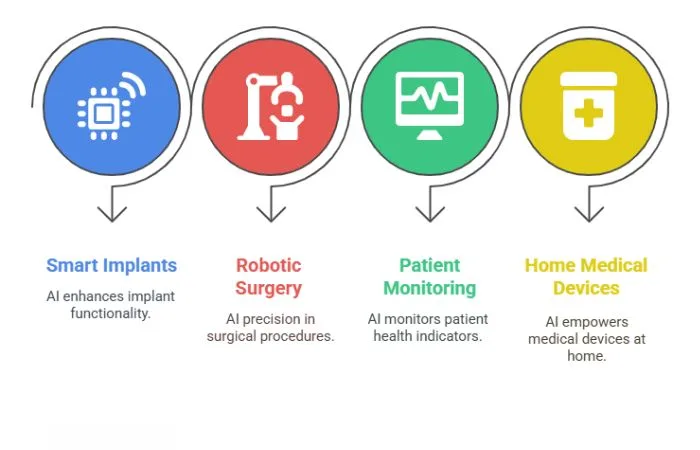

4. AI in Smart Implants and Prosthetics
4.1. Smart Orthopedic Implants
These implants collect biomechanical data to assess joint movement and loading. AI evaluates performance over time, detecting signs of wear, infection, or misalignment, which can lead to early, non-invasive interventions.
4.2. Bionic Limbs with AI
Advanced prosthetic limbs now use AI to interpret EMG (electromyographic) signals from muscles. The AI translates these signals into smooth, human-like movements, improving motor control and reducing fatigue in amputees.
4.3. Neurostimulators
Devices implanted in the spine or brain use AI to modulate electrical stimulation based on real-time feedback. In conditions like epilepsy or Parkinson’s disease, AI adapts the therapy dynamically, improving effectiveness and reducing side effects.
5. AI in Robotic Surgical Systems
5.1. Assistive Robotic Surgery
Surgical robots with AI capabilities enhance surgeon precision during complex procedures. These systems reduce tremors, suggest optimal cutting paths, and stabilize instruments for better outcomes and faster recovery.
5.2. AI for Surgical Decision Support
AI models analyze patient-specific data during surgery to suggest the next best action. For example, during tumor resection, AI can highlight tissue boundaries to help avoid damage to critical areas.
5.3. Post-Surgical Analysis
AI systems process video footage from surgeries to evaluate performance, identify errors, and improve training for surgeons. This “surgical intelligence” enhances patient safety and supports continuous learning.
6. AI-Integrated Patient Monitoring Devices
6.1. Smart Hospital Beds
These beds track patient movement, pressure points, and posture using AI to prevent bedsores and falls. They also adjust bed positions automatically to improve circulation and breathing.
6.2. AI-Based Vital Sign Monitors
Used in ICU or home settings, these monitors track heart rate, blood pressure, oxygen saturation, and respiratory rate. AI detects early signs of deterioration, triggering alerts before a crisis occurs.
6.3. Seizure Detection Devices
Wearable EEG headbands and body sensors use AI to analyze electrical activity and muscle movement to predict and detect seizures. Alerts are sent in real-time to caregivers or emergency services.
7. AI in Home-Based Medical Devices
7.1. Remote Patient Monitoring Kits
Kits including blood pressure monitors, oximeters, and thermometers collect daily readings. AI analyzes trends to detect early signs of disease progression, prompting virtual consultations or hospital visits when needed.
7.2. AI-Powered Inhalers
Smart inhalers track medication usage and detect improper inhalation technique. AI can predict asthma flare-ups based on environmental factors and patient history, increasing adherence and control.
7.3. Smart Thermometers with AI
These devices track temperature trends and compare them with community-level disease data. AI detects fever patterns that align with viral outbreaks, offering early warnings for contagious conditions like flu or COVID-19.
These applications prove that AI in medical devices is more than a trend, it’s a paradigm shift. Devices now think, learn, adapt, and communicate, turning passive tools into proactive healthcare allies.
Benefits of AI-Powered Medical Devices
The benefits of adopting AI in medical devices are vast and growing:
- Faster Diagnostics: Devices can instantly analyze complex datasets and flag critical issues.
- Personalized Treatment: AI models adjust outputs based on individual patient data, making care more tailored.
- Remote Monitoring: Enables continuous care for chronic conditions without hospital visits.
- Improved Accuracy: Reduces human error by offering second-opinion insights.
- Reduced Clinical Burden: Automates routine tasks, allowing professionals to focus on complex care.
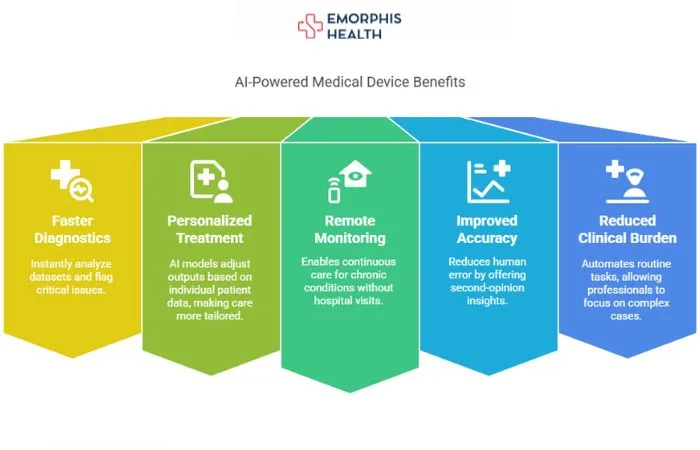

For healthcare buyers and hospital procurement teams, investing in AI healthcare tools means better patient outcomes and cost savings in the long run. Companies that sell AI-integrated medical devices often highlight these benefits as part of their product value proposition.
Compliance and Regulatory Landscape
As AI in medical devices becomes more prevalent, regulatory bodies are evolving to keep pace. In the United States, the FDA has issued guidance on Software as a Medical Device (SaMD), including AI components. The European Union’s MDR (Medical Device Regulation) also outlines strict requirements for devices using machine learning algorithms.
Manufacturers must ensure transparency, accuracy, and data security when designing AI-based medical devices. Continuous monitoring and post-market surveillance are also crucial, as AI models can change over time (a phenomenon known as algorithmic drift).
Healthcare buyers looking to adopt AI-powered medical equipment must also evaluate vendor compliance, cybersecurity measures, and clinical validation to ensure patient safety and regulatory alignment.
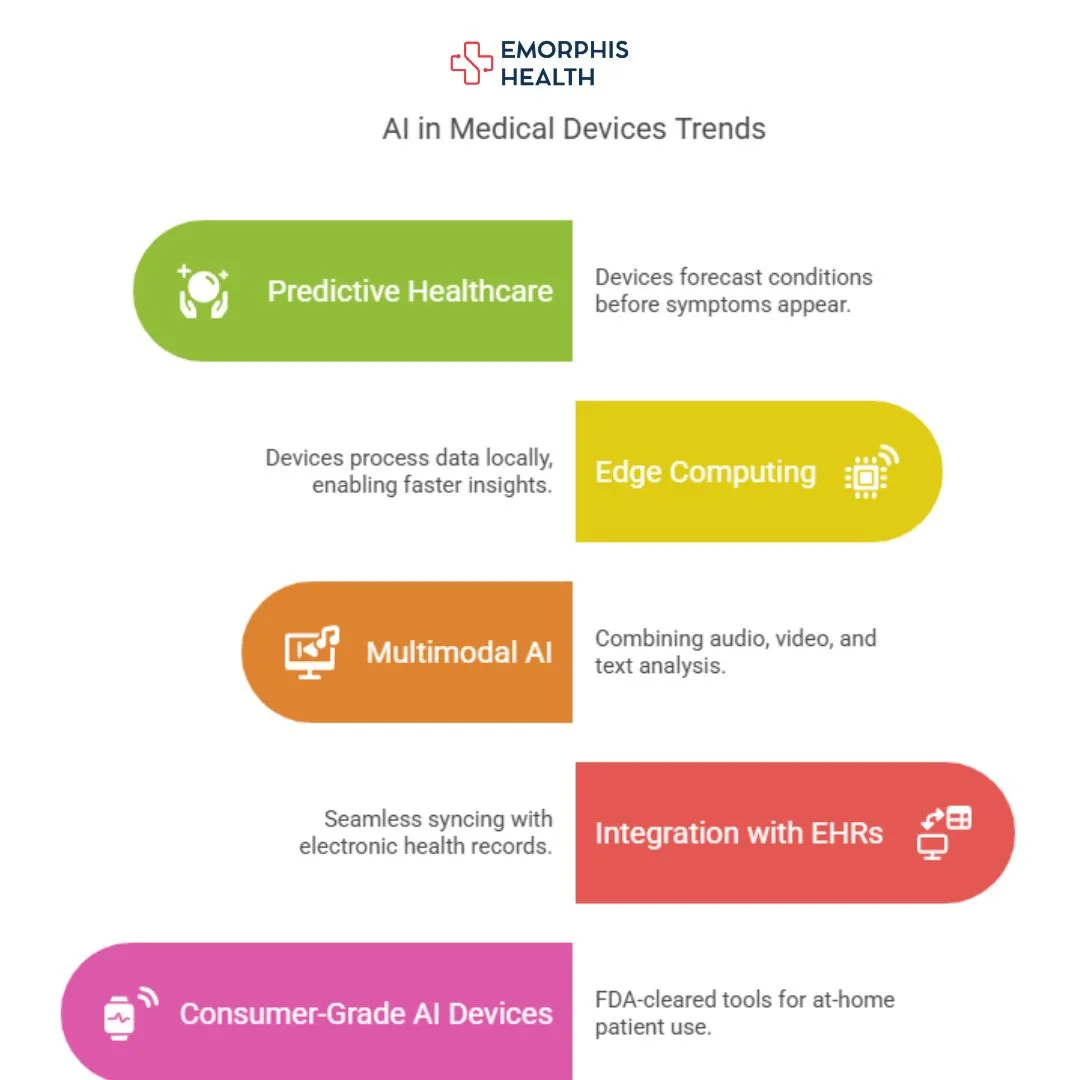

The Future of AI in Medical Devices
The future of AI in medical devices is incredibly promising. As algorithms become more sophisticated and hardware more efficient, we’ll see greater autonomy in devices. Trends include:
- Predictive Healthcare: Devices that forecast conditions before symptoms appear.
- Edge Computing: More devices will process data locally, enabling faster, offline insights.
- Multimodal AI: Combining audio, video, and text analysis for deeper context.
- Integration with EHRs: Seamless syncing with electronic health records for full patient visibility.
- Consumer-Grade AI Devices: FDA-cleared tools for at-home use by patients.
For healthcare providers and procurement teams, now is the time to invest in AI-integrated medical devices. Not only are they the future, but they are also quickly becoming a competitive necessity in delivering high-quality care.
Conclusion: The Rise of Intelligent Devices in Healthcare
AI in medical devices is not just a technological trend, it is the future of medicine. From smart sensors and wearables to surgical robotics and diagnostic tools, AI is embedded into the devices that define modern healthcare.
For hospitals, clinics, and even startups looking to buy AI healthcare equipment, the benefits include increased efficiency, reduced errors, and more personalized care. As regulatory clarity improves and hardware becomes more advanced, we can expect AI in medical devices to become the new gold standard in medical innovation.
The thermometer with a brain is only the beginning. Welcome to the intelligent age of healthcare.

